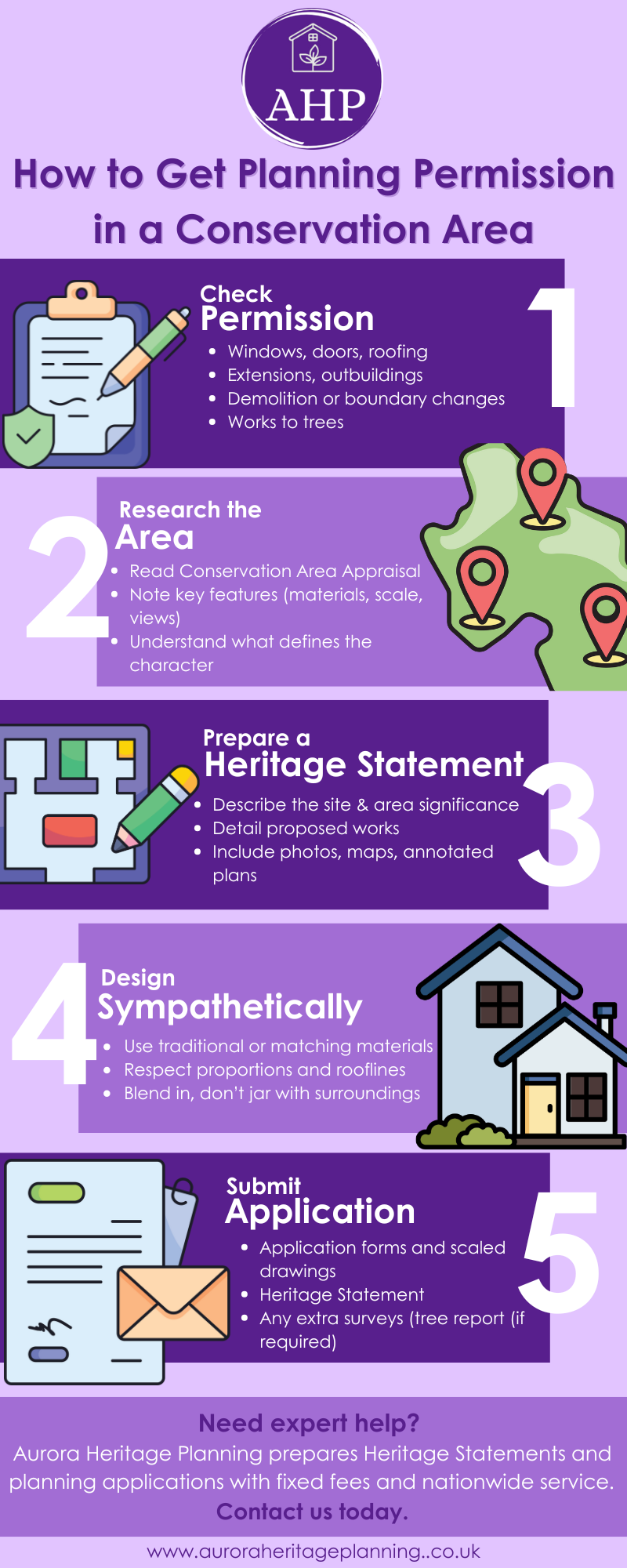If you live in a conservation area, you’ll already know it’s both a blessing and a challenge. You enjoy historic charm and character – but strict planning controls can make even small changes feel complicated.
The truth is, many planning applications fail because homeowners or developers don’t understand the additional requirements councils expect. This can lead to costly delays, redesigns, or outright refusals.
In this guide, our team at Aurora Heritage Planning – specialists in conservation and heritage planning – share a simple step-by-step process to help you secure planning permission in a conservation area. You’ll learn how to avoid common pitfalls, prepare stronger applications, and get expert support along the way.
Why Conservation Areas Matter
Conservation areas are designated to protect places of special architectural or historic interest. Councils are particularly cautious about changes that could alter their character – from large extensions to seemingly small alterations like new windows or external finishes.
Under the National Planning Policy Framework (NPPF), local authorities must consider the impact of proposals on the “significance of heritage assets”, which includes conservation areas. The goal isn’t to freeze areas in time, but to manage change sensitively.
👉 Tip: This is where heritage planning consultants like Aurora can help. We ensure your project is designed and documented in a way that meets council expectations from the start.
Step 1: Do You Need Planning Permission in a Conservation Area?
Not all work requires permission, but rules are much stricter in conservation areas. Common projects that may require consent include:
👉 Tip: Don’t assume your project is exempt. “Permitted development” rights are often restricted in conservation areas. Check with your local council or ask Aurora for advice before starting.
Step 2: Research the Character of the Conservation Area
A strong application shows you understand the setting. Before drawing up plans:
This context forms the foundation for your application and proves your design respects the area.
Step 3: Prepare a Heritage Statement (or Heritage Impact Assessment)
Most applications in conservation areas require a Heritage Statement.
👉 Tip: Supporting visuals (maps, photos, annotated plans) make your case stronger. Aurora’s team prepares professional heritage statements that give your project the best chance of approval.
Step 4: Use Sympathetic Designs and Materials
Design choices are closely scrutinised in conservation areas. To boost your chances:
Step 5: Submit a Strong Application
When you’re ready to apply (via the Planning Portal or your local council), make sure you include:
👉 Tip: A clear, professional submission reduces back-and-forth with planning officers – and Aurora can prepare the full package for
Step 6: Be Ready for Consultation
Once submitted, your application will go through a consultation process. Local groups, councillors, and neighbours may comment.
Aurora’s Perspective: Planning Made Simple
At Aurora Heritage Planning, we know how overwhelming conservation area rules can feel. Our role is to make the process straightforward and stress-free.
Whether it’s a small alteration or a larger redevelopment, our supportive team will guide you every step of the way – preparing the right documentation, liaising with councils, and helping you avoid costly mistakes.
Quick Checklist for Success
✔ Confirm if your works need permission
✔ Research your conservation area’s character
✔ Prepare a professional Heritage Statement
✔ Use sympathetic designs and materials
✔ Submit a complete, well-documented application
✔ Engage positively during consultation
Ready to Get Started?
Don’t risk delays or refusals. Aurora Heritage Planning can prepare clear, persuasive documentation that gives your project the best chance of approval.
👉 Contact us today for a fixed-fee quote and expert support with your conservation area planning application.
